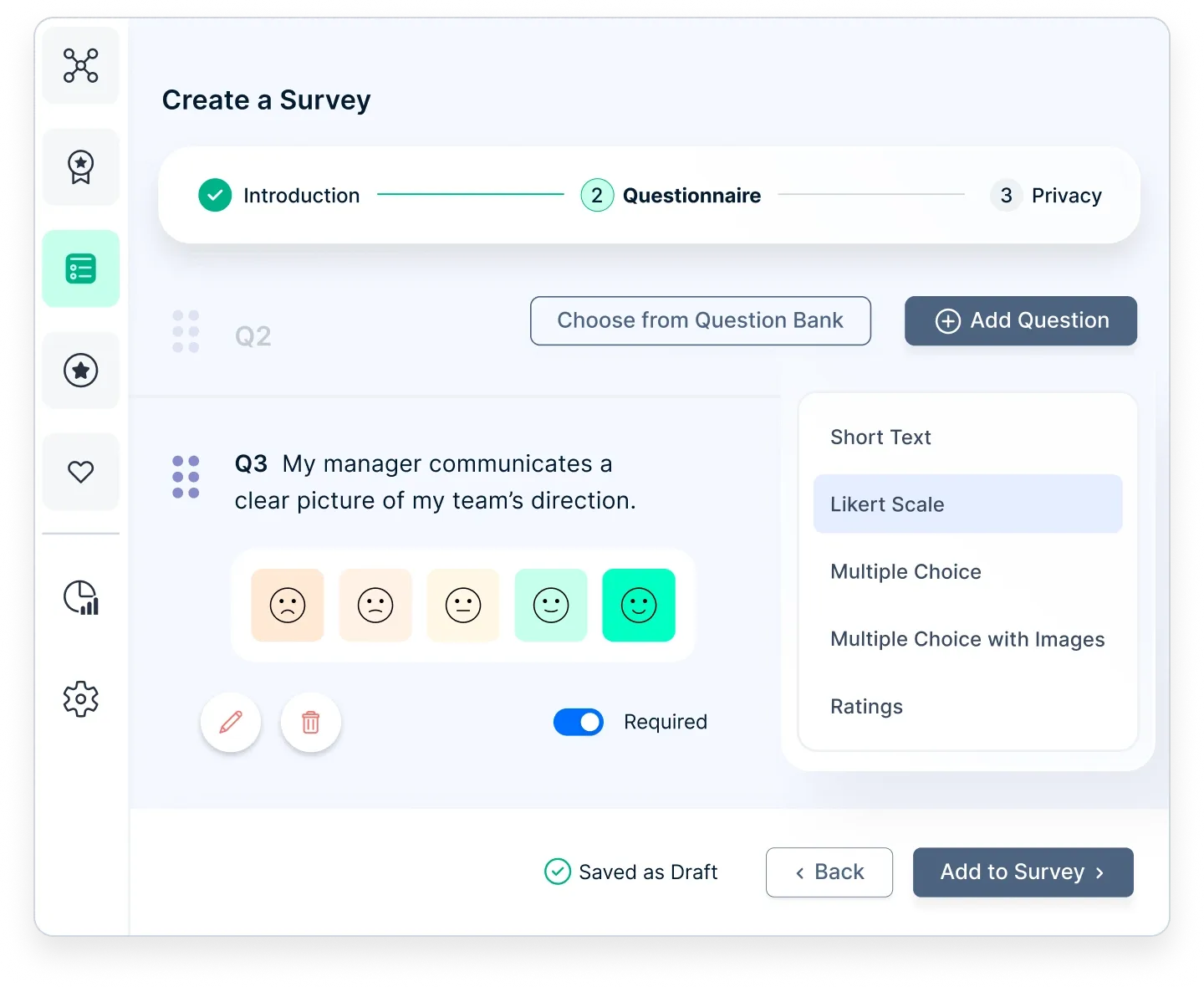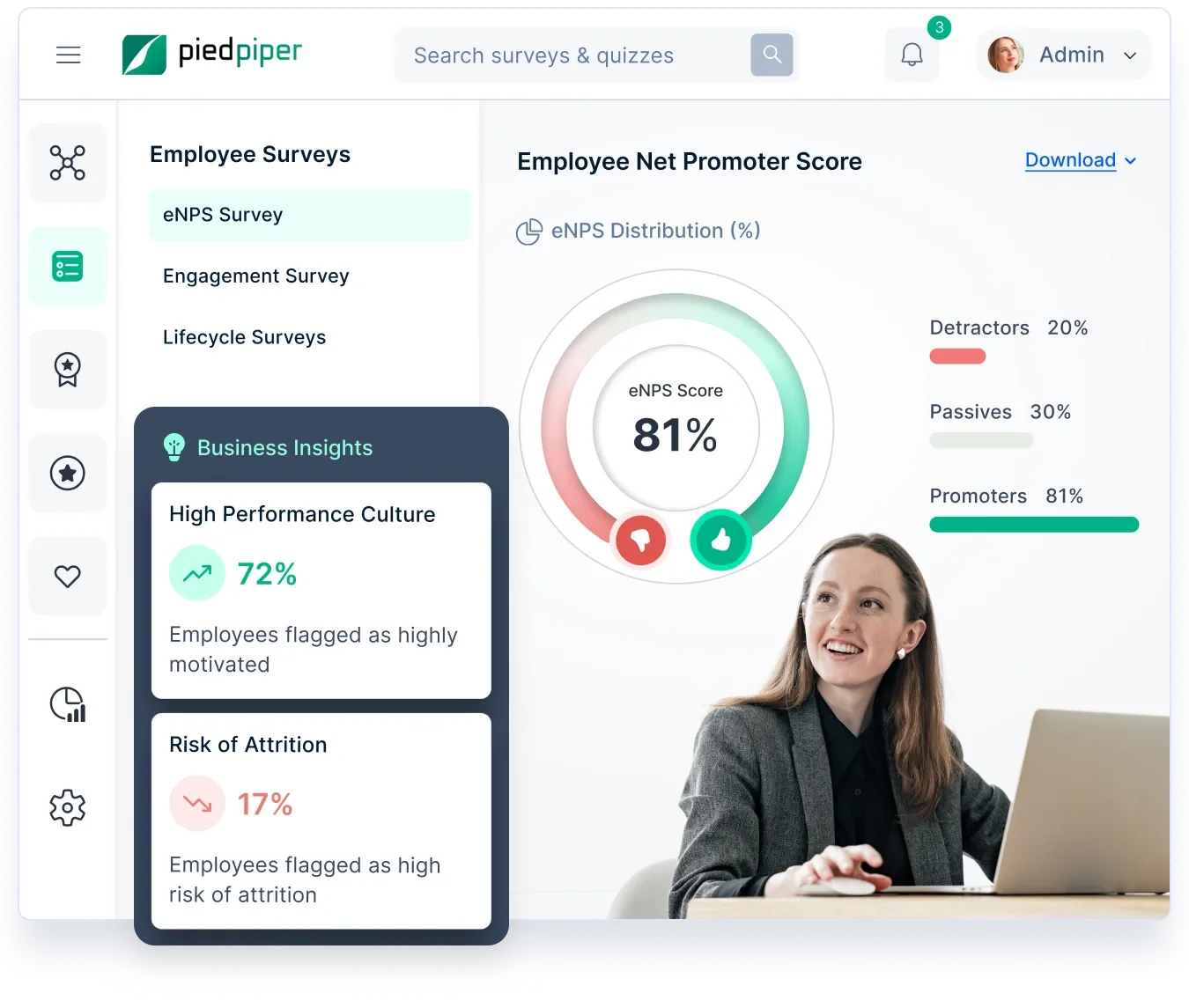Employee Engagement Survey Questions: What to Ask & What to Avoid [+20 Must Ask Questions]
Asking the right employee engagement survey questions is key to understanding workplace sentiment and improving engagement. Well-crafted questions provide actionable insights, helping businesses boost employee motivation and productivity.
On this page
- Rules on how to design an employee engagement survey questionnaire when conducting a survey
- Creating effective employee engagement survey questions
- Types of employee engagement survey questions
- Open-ended questions for employee engagement surveys
- 20 Examples of employee engagement survey questions you must ask
- Types of questions to avoid in your employee engagement survey
- Use Empuls to simplify employee engagement surveys with data-driven insights
- Conclusion
Business success depends on many factors, but employee engagement is a key driver of productivity and growth. Engaged employees go beyond basic job satisfaction—they are motivated, committed, and contribute to organizational success.
Employee engagement survey questions help measure workplace sentiment, leadership effectiveness, and job motivation. Well-structured questions uncover insights that improve workplace culture and employee well-being. But how do you ask the right questions to get meaningful feedback?
It’s important to distinguish engagement from satisfaction—a satisfied employee isn’t always engaged, but an engaged employee is likely happy. A carefully designed employee engagement survey helps organizations identify what drives motivation and where improvements are needed.
Rules on how to design an employee engagement survey questionnaire when conducting a survey
There is a set of rules that you need to consider before you create an employee engagement survey:
- The respondent should know who is conducting the survey and why.
- Ensure that the responses are accurate.
- The respondent clearly understands the content of each question.
- Each survey question has to have one meaning, no several questions in one.
- All employee engagement questions need to be designed to imply a reasonable and accurate answer.
- All employee engagement questions should be grammatically correct.
- The content of the question shouldn’t offend the respondent or demean their dignity.
- The interviewer does not impose response options on the respondent behave neutrally.
- The number of questions is consistent with common sense and does not lead to the respondent's excessive intellectual and psychological overload.
- The entire system of questions and answers is sufficient to obtain the necessary information to solve research problems.
To run a successful survey, you need to make sure your employee engagement survey questions follow these four key elements:
- They’re clear, unambiguous, and pointed.
- They’re worded neutrally.
- They only ask one thing at a time.
- They ask about something you can change or improve.
These guidelines will ensure you can get clear and actionable data from your engagement survey. If your employee engagement questions for the survey are worded poorly, you might be more confused after getting answers than before!
When creating your employee engagement survey, one final guideline: ensure it’s not too long. Of course, you want to get feedback on plenty of topics - but your employees are already busy doing their jobs.
The longer you expect them to drop everything and answer your survey, the more people will drop out without answering all your questions. Shorter is more effective.
The content of the questions determines the quality of the survey, the quality of the work of the questionnaires or interviewers, and the survey conditions.
Formatting tips
Even though you might want to format your questionnaire as you like, several psychological tricks might grant you as objective results as possible:
- It is better to print the questions and answers in different font sizes to differentiate between them clearly.
- Any explanations should also be highlighted (for instance, written in italics).
- Allocate enough space for answers to open-ended and semi-closed questions.
- Avoid situations when some variants are moved to the next page, as respondents might consider them less significant.
Creating effective employee engagement survey questions
An employee engagement survey is one of the best ways to understand how employees feel about their work, whether they find it meaningful, and how motivated they are daily. However, simply asking a few vague questions won’t provide the insights needed to improve engagement.
Crafting the right employee engagement survey questions is key to gathering actionable feedback. The wording, structure, and clarity of questions impact the quality of responses. A well-designed survey helps identify key focus areas, such as declining productivity, employee perception of new initiatives, or reactions to company changes.
To ensure accurate and meaningful feedback:
- Keep questions clear and straightforward to avoid confusion.
- Maintain anonymity to encourage honest responses.
- Focus on specific engagement drivers, like job satisfaction, company culture, and autonomy.
Sample questions may include:
- Do you feel valued in your role?
- Would you recommend this company to a friend?
- Do you find your work meaningful and challenging?
- Where do you think the company can improve?
Once results are analyzed, share key findings with employees and outline clear action steps. A survey should lead to real improvements, reinforcing trust and ensuring employees see their feedback making an impact.

Drive Employee Engagement with Actionable Insights
Design custom employee surveys, analyze responses with AI, and make data-backed decisions to enhance workplace culture—all with Empuls.
Types of employee engagement survey questions
Suppose you are not one of the professionals who provide immigration essay writing services. In that case, you probably may not know that you can use different types of questions in your questionnaire.
There are two types of employee engagement survey questions:
1. Closed-ended employee engagement survey questions
Closed questions are those that contain one or more possible answers. Closed questions are used when it is necessary to reveal a person’s awareness of a particular problem or describe specific aspects.
Requirements for compiling closed questions:
- The list of answers should be exhaustive. It is necessary to foresee all possible answers in advance.
- It is desirable to have the least likely among the first answers.
- All answer options must be sustained at the same level of specificity.
Closed-ended questions are usually asked by respondents from a specific set of responses. For example, questions with only ‘yes’ or ‘no’ answers. This could also include questions with a particular set of multiple-choice answers.
Closed-ended questions are advantageous when you need to survey on a large scale. This is because they tend to take less time to answer. Another advantage of closed-ended questions is that they are not complicated.
Participants can easily understand what is being asked and select the most relevant answer. These questions are great for gaining general insights but don’t allow participants to give more in-depth answers and thoughts.
Semi-closed questions provide an opportunity to evade the pre-proposed answers and indicate your version in a dedicated line. Direct questions are formulated personally (for example, “Do you like your work?”).
An indirect question allows the respondent to express from the group's position, the team; it is used when the personal life of the respondent is affected, their attitude towards negative phenomena.
2. Open-ended employee engagement survey questions
In open-ended questions, the respondents' possible answers are not given to them, and they must independently formulate and write down the answers.
It is preferable to use open questions if it is necessary for the respondent to substantiate their opinion and explain why they think so.
Open-ended employee engagement survey questions are the ones that do not have straightforward ‘yes’ or ‘no’ answers. These questions require participants to elaborate and explain their answers.
Open-ended employee engagement questions are usually used to describe their answers and feedback and put across their feelings and/or concerns.
They provide freedom for participants to answer however they want to, instead of restricting their answers.
3. Close-ended vs. open-ended questions
Although closed-ended engagement questions have plenty of advantages, such as being time-efficient and easy to go through, they are also very limiting as respondents can only select from a set of answers.
Because of this, it’s better to use open-ended engagement questions for employee engagement surveys. They allow your employees to elaborate and articulate their thoughts and opinions better.
Since you must be clear about open vs. closed-ended questions, keep in mind that employee engagement surveys must incorporate both close-ended and open-ended questions.
Doing so ensures that you get an all-around measurement regarding your employee engagement.
Open-ended questions for employee engagement surveys
To gain better insight into how your company can do better and improve employee satisfaction, here are five open-ended employee engagement questions you can include in your employee engagement survey.
1. In what ways can the company make things better?
This is one of the important, open-ended engagement questions because it allows employers to see what employees aren’t quite happy with within the company.
It gives insight into the areas that need improvement so that the workspace is better for them. Creating a workspace where your employees think about their happiness, comfort, motivation, and fulfillment is vital.
With the answers to this question, you can improve the workspace, improving work performance.
2. In what ways does your manager/employer recognize the work you do for the company?
This question concerns recognition and whether or not your employee feels recognized. Do they feel like they are being rewarded for their work?
It is essential that your employees feel like their hard work does not go unnoticed. Otherwise, you risk your employees becoming utterly unmotivated and, therefore, unproductive. We all know that recognizing and rewarding your work is the best and most fulfilling feeling in the workspace.
Companies with good employee recognition programs can improve employee retention and see a 31% lower voluntary turnover rate!
So, this question allows you to see where you’re going right or wrong about recognition and rewarding your employees’ hard work.
3. What three words or phrases best describe the communication within your team?
This question is important as it explores team collaboration and dynamics. Collaboration and effective communication between a team employees, and employers are essential in fostering a productive and motivated work environment.
Communication is a vital driver of engagement and a key factor in productivity, motivation, and employee retention. This question is great because it allows you to see what your employees think of the communication systems you have put in place.
They can also give you an idea of improving those communication systems. Poor communication is frustrating and is a driving factor in high employee turnover.
So, it would be best to foster good communication and engagement to avoid that.
4. In what ways does the company make you feel valued?
It is crucial that your employees feel valued and appreciated. If your employees feel valued, they are more likely to be loyal to the company - even if some things about the company aren’t perfect. This is how you also decrease employee turnover.
Employees feeling valued and appreciated could lead to heightened job satisfaction and performance improvement. So, this question is one of the best ways to determine whether your employees feel valued.
After seeing what your employees say, you can implement the appropriate changes so that your employees know you appreciate them. Even a simple ‘thank you’ goes a long way in employee satisfaction. Studies indicate that 85% of employees would be happy with that simple gesture of appreciation.
5. What type of feedback do you receive from your management team?
Receiving useful and productive feedback is important to your employees’ development in the company. It is, quite frankly, one of the best things employers can provide.
Feedback is beneficial because it helps employees learn from their errors and build confidence. Constructive feedback also clarifies expectations so your employees aren’t confused about what they need to do.
This question is essential because you allow employees to reflect on the feedback they receive and whether it benefits them. You can see if employees aren’t getting helpful feedback by doing this.
Or your employees may find that the feedback they get is too infrequent or even too harsh. Knowing these insights will help you improve your feedback methods to grow better and develop your skills.
20 Examples of employee engagement survey questions you must ask
Now we’re onto the good stuff - the simple but effective questions you must include in your employee engagement survey.
You don’t need to include everyone; you can certainly add others that fit your organization’s priorities. But these should give you a great start on building your survey.
Here is the list of the best questions for the employee engagement survey.
1. Would you recommend [Company] as a great place to work?
If your employees recommend working at your company to their friends and family, that speaks highly of how they regard your organization.
2. Do you feel empowered at work?
Feeling empowered to do their work without being micromanaged helps employees feel autonomous and trusted - and that leads to higher engagement.
3. Do you look forward to coming to work every morning?
If employees dread coming into work most mornings, that’s a sign that something is seriously wrong with your workplace. That is a major factor in feeling disengaged.
4. Do you plan to work at this company in two years?
Engaged employees don’t tend to look for other roles actively - if your people are looking for a way out, there’s something you need to fix fast.
5. Do you feel aligned with the company’s goals?
When employees feel they’re working towards a clear goal and the rest of the organization, that helps them feel like they’re contributing to something larger than themselves - and that feeling boosts engagement. It helps employees “focus on the why.”
6. Does your manager care about you as a person?
Our direct manager has such a strong impact on our days at work. Employees who feel cared for by their managers tend to have higher engagement levels.
7. Do you think the management team is transparent?
If employees don’t feel they can trust what their senior leaders say. That distrust and disconnection can lead to dissatisfaction and lower engagement.
8. Do you feel your manager values your opinions?
It’s important to feel like you can express yourself at work and bring up issues or solutions to your manager. Do your employees feel safe doing that?
9. Do you have a good working relationship with your colleagues?
Let’s be real - we spend so much of our lives at work, our colleagues are some of the people we spend the most time with. If employees feel their workplace is full of infighting, competitiveness, or lacking trust, that can feel discouraging and stressful.
10. Do you feel you can be your whole self at work?
When employees feel they need to hide part of themselves at work (like their gender pronouns), or like their coworkers or leaders don’t accept the essential part, they can begin to feel increasingly disengaged and look for a workplace to feel more accepted at home.
11. Do you think the company cares about your physical and mental wellbeing?
Feeling cared for at work is a great feeling. If employees feel your company cares about their physical welfare, like having a safe and comfortable work set up, and their mental wellbeing by ensuring they have plenty of time off and reducing burnout, that contributes to a less stressed, more engaged workforce.
12. Do you feel recognized for your hard work and successes in your job?
Recognizing and rewarding employees for a job well done, whether on a huge project or a small task, is vital to keeping them engaged. After all, if you work hard but it’s never acknowledged, that’s a really discouraging experience.
If you don’t know how often employees feel recognized, you won’t know what steps to take to improve the situation (like using Empuls to recognize and reward easy and fun).
13. Do you have a best friend at work?
This question comes from the gold standard of engagement surveys: the Gallup Q12 employee engagement questionnaire. It might seem a little odd, but Gallup asks it because they have found a significant link between having a best friend at work and increased effort in the job.
14. Are you recognized fairly for your contributions to your team?
If your team is lucky enough to have a superstar performer, are they recognized for their individual contributions? Or are they mostly just getting lumped in with the rest of the team? That experience can be frustrating is high performers feel they’re often covering for low ones.
15. Are you satisfied with the benefits the company offers?
The range of benefits employees expect from their employers has grown - some companies offer new perks like pet insurance, in-office wellness centers, and more. How do your employees feel you’re stacking up?
16. Does your team inspire you to do your best work?
The people who surround us every day can encourage us to reach new heights of excellence - or their bad attitudes and lazy approach to work can drag us down. How do your employees feel about their close colleagues?
17. Have leaders at [Company] communicated a vision that motivates you?
Do your employees feel a clear connection between the work they do and your company's vision and goals as a whole? If your leaders lack that kind of communication, you might be missing a chance to boost engagement and results.
18. Do you have access to the tools and technology you need to do your job well?
Sure, you might think you’ve provided employees with everything they need to do their jobs. But you’re a leader - you’re not there in the day-to-day grind. Checking in to see if something missing would help them do their jobs to the best of their ability could lead to big productivity gains.
19. Do you know what you need to do to succeed in your role?
People can’t succeed unless they know what they’re supposed to be doing. This might seem simple, but there can be a surprisingly big disconnect between what employees think their role is and what managers and leaders expect.
20. Do you believe there are good career opportunities for you at this company?
One of the biggest reasons great employees leave your company is because they don’t see a solid, promising career path ahead of them. Is this an issue you need to address? Find out by asking employees directly.

Download Free Survey Templates to Capture Employee Sentiment
Use expert-designed templates to track employee engagement, job satisfaction, and workplace culture. Get instant access to the templates that fit your needs.
Types of questions to avoid in your employee engagement survey
A well-designed employee engagement survey helps organizations gain meaningful insights, but poorly structured questions can lead to misleading responses, survey fatigue, or inaccurate data. Here are seven types of questions to avoid when crafting your survey.
1. Leading or biased questions
Questions that push employees toward a specific answer can distort survey results. Instead of “How satisfied are you with our excellent leadership?”, ask “How would you rate leadership support in the company?”
2. Vague or ambiguous questions
Unclear wording confuses employees and leads to inconsistent responses. Instead of “Do you feel supported at work?”, specify “Do you receive timely support from your manager when needed?”
3. Double-barreled questions
These combine multiple topics into one, making it hard to answer accurately. Avoid “Do you feel valued and have growth opportunities?”—split it into two separate questions.
4. Too many open-ended questions
While open-ended questions provide rich insights, too many can overwhelm employees and reduce participation. Use them sparingly and balance them with scaled or multiple-choice questions.
5. Negatively framed questions
Negative wording can create confusion. Instead of “Do you feel unsupported by your manager?”, ask “How would you rate the level of support provided by your manager?”
6. Questions that invade privacy
Employees may feel uncomfortable answering overly personal questions. Avoid anything that touches on private matters unrelated to engagement, such as personal beliefs or health conditions.
7. Overly long or complex questions
Long-winded or technical questions reduce engagement and can lead to survey drop-offs. Keep questions short, clear, and concise to ensure high response rates.
A well-crafted employee engagement survey focuses on clarity, neutrality, and relevance. Avoiding these mistakes will lead to more accurate insights and actionable feedback that help improve workplace culture and employee satisfaction.
Use Empuls to simplify employee engagement surveys with data-driven insights

Crafting the right employee engagement survey questions is essential, but gathering and analyzing responses effectively is just as important. Empuls makes this process seamless by offering a powerful employee engagement survey platform that helps organizations measure, analyze, and act on employee feedback in real-time.
With AI-powered analytics, automated pulse surveys, and anonymous feedback options, Empuls ensures you collect accurate and actionable insights without overwhelming employees. Whether you need customizable templates or in-depth reporting, Empuls helps you design surveys that capture workplace sentiment.
With Empuls you get,
- Ready-to-use survey templates to get started quickly.
- AI-driven sentiment analysis for deeper insights.
- Anonymous and confidential surveys to encourage honest feedback.
- Real-time dashboards to track engagement trends and improvements.
- Automated survey scheduling to ensure continuous employee feedback.
With Empuls, engagement surveys go beyond just collecting data—they become a strategic tool for improving workplace culture and boosting employee satisfaction.
Conclusion
An employee engagement survey is only effective if it asks the right questions. Thoughtful, well-structured questions help uncover real insights, ensuring employees feel heard and valued.
However, gathering feedback is just the first step. Sharing results transparently and taking actionable steps build trust and encourage future participation. When employees see meaningful changes, engagement improves.
By following best practices, businesses can foster a culture of continuous improvement, where employees stay motivated, connected, and committed to success.
FAQs
1. What are the best employee engagement survey questions?
The best questions focus on job satisfaction, leadership, workplace culture, and growth opportunities. Examples include "Do you feel valued at work?" and "What would improve your overall engagement?"
2. How often should an employee engagement survey be conducted?
Surveys should be conducted annually or quarterly, depending on the organization's needs. Pulse surveys can be used more frequently to track engagement trends.
3. How do you encourage employees to participate in engagement surveys?
Ensure anonymity, explain the purpose of the survey, and highlight how past feedback has led to improvements. Clear communication and leadership support also boost participation.
4. What is the difference between employee satisfaction and engagement?
Satisfaction reflects general workplace contentment, while engagement measures motivation, commitment, and emotional investment in work. Engaged employees go beyond basic satisfaction.
5. How many questions should an employee engagement survey have?
A well-balanced survey should include 10-20 concise, relevant questions. Too many can cause survey fatigue, while too few may not provide meaningful insights.
6. Should employee engagement surveys be anonymous?
Yes, anonymity encourages honest feedback, leading to more accurate and actionable insights. Employees should feel safe sharing their true opinions.
7. How do you analyze employee engagement survey results?
Look for patterns and trends in responses, segment data by departments or roles, and compare results to past surveys to track improvements or areas needing attention.
8. What should be done after gathering employee engagement survey results?
Share key findings transparently, discuss them with employees, and implement targeted improvements. Following up with action builds trust and increases future survey participation.


















